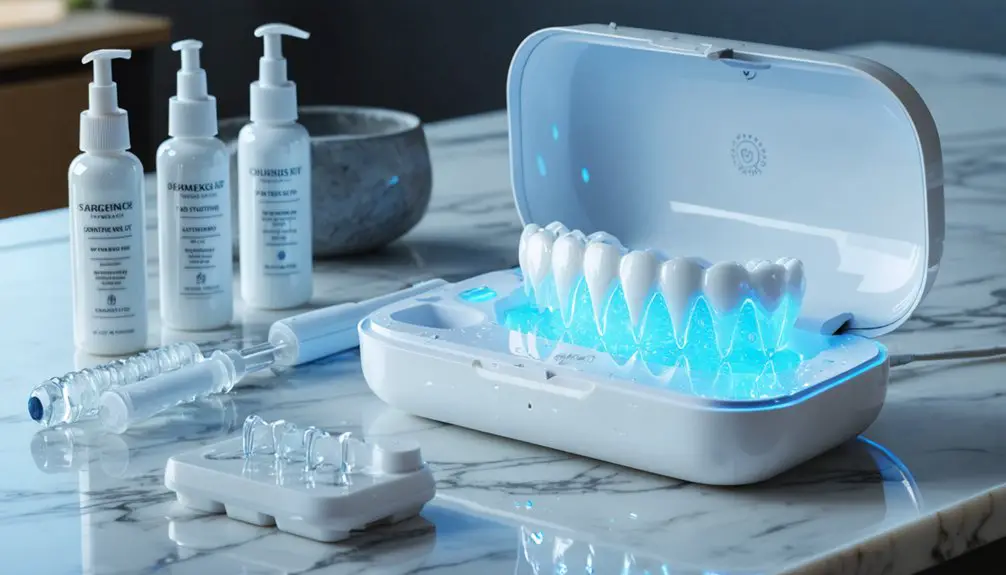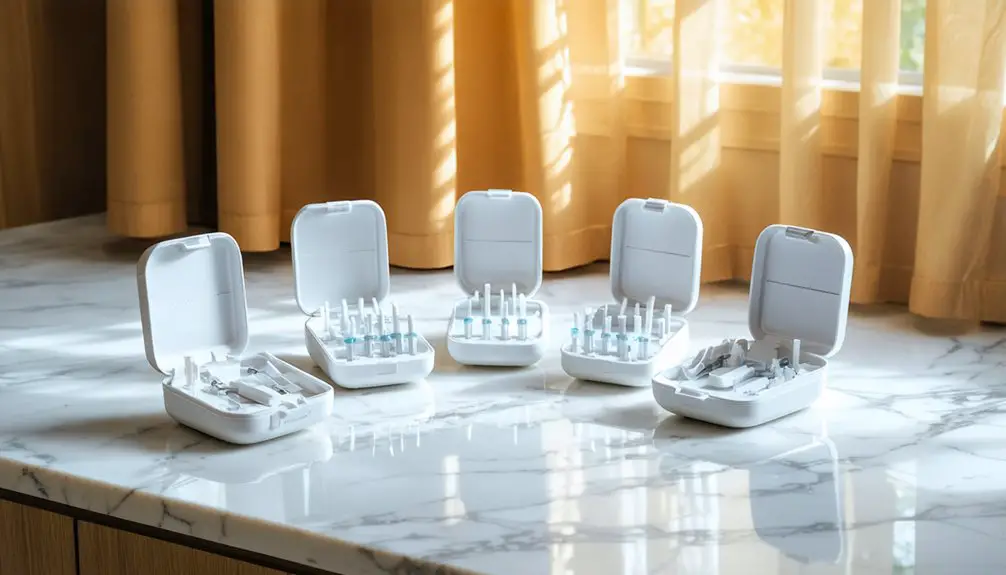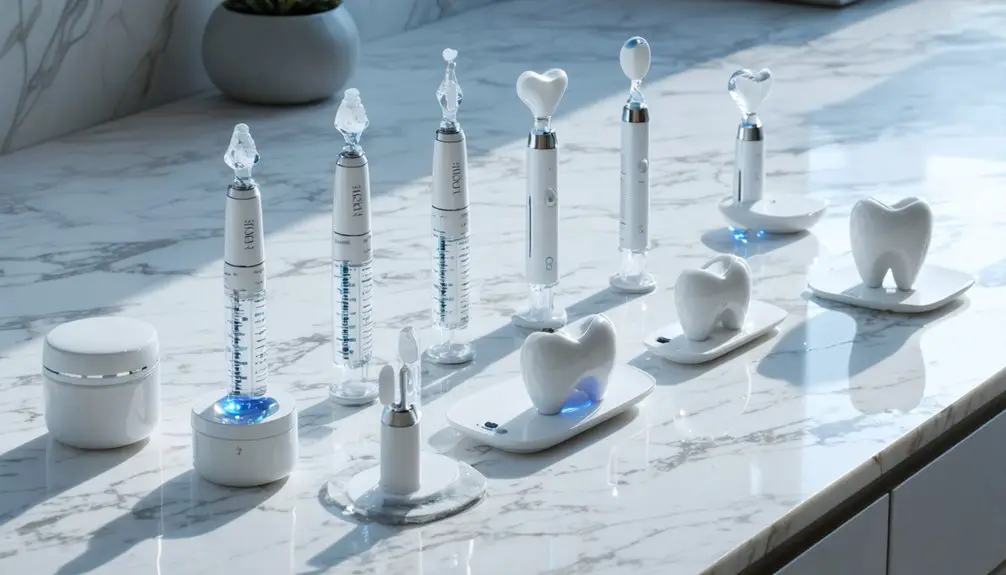You’ll achieve ideal results with LED teeth whitening by following these essential tips: schedule a pre-treatment dental check-up, store gels at room temperature, thoroughly clean teeth before application, apply gel in thin uniform layers, maintain 9-30 minute sessions over 14-21 days, allow recovery time between treatments, avoid staining foods, use desensitizing products if needed, track progress with photos, and schedule periodic touch-ups. Understanding proper technique and maintenance protocols will maximize your whitening success.
Key Takeaways
- Schedule a dental check-up before starting treatment to address any underlying issues and ensure your teeth are suitable for whitening.
- Apply whitening gel in a thin, uniform layer covering 4-6 teeth, allowing it to dry for 10-15 seconds before using LED.
- Follow recommended session lengths of 9-30 minutes daily over 14-21 days, with 24-48 hours recovery between treatments.
- Avoid staining foods and beverages for 48 hours before and after treatment, using a straw when drinking cold beverages.
- Track progress using a shade guide every 3-5 days and maintain results with regular touch-up sessions every few months.
Pre-Treatment Preparation for Best Results
Before beginning LED teeth whitening treatment, proper preparation is essential to achieve optimal results and minimize potential sensitivity.
Schedule a pre-whitening assessment and dental consultation to address any existing oral health issues that could interfere with treatment. You’ll need to verify your teeth and gums are in prime condition before proceeding.
Start with thorough oral hygiene by brushing carefully with fluoride toothpaste and flossing to remove all debris. SNOW teeth whitening toothpaste provides superior cleaning performance for optimal pre-treatment preparation. Gently dry your teeth with a clean tissue for better whitening gel adhesion. Use a soft-bristled toothbrush to protect your gums, and rinse thoroughly afterward.
Consider using desensitizing products in the days leading up to treatment if you have sensitive teeth. Clean, dry teeth will allow the whitening gel to adhere properly and penetrate evenly.
Choose a quiet time and comfortable setting for your treatment to verify proper application and maximum effectiveness.
Understanding Your LED Kit Components
Your LED teeth whitening kit contains essential components including the LED mouth tray, whitening gel syringes, USB charger, and shade guide for tracking your progress.
You’ll need to store your whitening gels at room temperature away from direct sunlight to maintain their effectiveness for up to a year.
The LED light activation process begins once you’ve properly fitted the mouth tray and applied the prescribed amount of gel to achieve ideal whitening results. The kit’s 32 LED lights work together to accelerate and enhance the whitening process.
Professional-level results can be achieved with just 10 minutes daily of consistent treatment use.
Essential Kit Parts Explained
Modern LED teeth whitening kits contain several essential components that work together to deliver professional-grade results at home.
Your kit’s whitening gel features peroxide-based active agents, typically in concentrations between 10% and 45%, along with sensitivity-reducing ingredients like potassium nitrate and xylitol.
The LED device emits specific wavelengths (400-420 nm) to accelerate the whitening process while remaining lightweight and comfortable.
You’ll find custom-fitted or pre-formed trays made from medical-grade materials that secure the gel against your teeth. Application times for these teeth whitening trays typically range from 20 to 60 minutes per session.
Unlike some treatments, the powerful whitening agents can effectively permeate the entire tooth without needing direct contact on every surface.
The gel delivery system, often in syringe form, guarantees precise application and maintains product stability.
Most kits also include desensitizing treatments, storage cases, and detailed instructions to optimize your whitening experience and protect the components between uses.
Safe Gel Storage Methods
Proper storage of teeth whitening gels plays an essential role in maintaining their effectiveness and safety during treatment.
Keep your gels at temperatures between 59°F and 80°F to prevent gel degradation, and store them in a cool, dry place away from bathroom humidity and direct light exposure.
Ensure proper sealing of syringes or tubes immediately after each use to prevent oxidation and contamination. Using clean handling tools helps prevent introducing bacteria when accessing your whitening gels. Tightly seal your whitening gels to ensure they remain contaminant-free and maintain optimal performance.
While refrigeration can extend shelf life up to 24 months, never freeze the gels as this alters their composition.
Once opened, use the gel within 30 days for ideal results. Monitor for any changes in color, consistency, or odor before each application, and discard if you notice these signs.
Store your whitening trays in their cases after thoroughly air-drying them, keeping them in the same controlled environment as your gels.
LED Light Activation Steps
When beginning LED teeth whitening treatment, understanding your kit’s components is essential for achieving excellent results. Your LED device’s mechanics work by activating peroxide-based gels through specific light wavelengths, breaking down stains within your tooth enamel. You can expect to achieve up to 10 shades whiter within a week of consistent use. Professional dentists recommend using custom-fitted trays with LED devices for optimal coverage and effectiveness.
- Check your LED mouthpiece’s fit and confirm it’s properly charged or connected before starting.
- Apply whitening gel evenly to avoid over-saturation that could cause sensitivity.
- Select the appropriate light mode if your device offers multiple settings (blue for whitening, red for gum care).
- Monitor activation timing carefully, typically 10-30 minutes per session.
Always follow your kit’s specific instructions for best results.
The LED light enhances the whitening process by accelerating the gel’s oxygen release, making each session more effective than gel treatments alone.
Proper Application Techniques
Successful LED teeth whitening relies heavily on precise application techniques to maximize results and minimize sensitivity.
Despite common whitening myths, proper preparation is vital – brush thoroughly but wait several days after dental cleanings if you’re prone to sensitivity. Avoid these application mistakes by working in a clean, dry environment.
Apply the whitening serum in a thin, uniform layer using the precision applicator, covering 4-6 teeth with each drop. Let it dry for 10-15 seconds before positioning the LED device.
You’ll want to maintain steady positioning during the 5-10 minute treatment to guarantee even activation. Don’t exceed recommended treatment times, and keep the gel away from gums and artificial dental work.
Clean your applicator after each use and store your device properly to maintain peak performance.
Managing Treatment Duration and Frequency
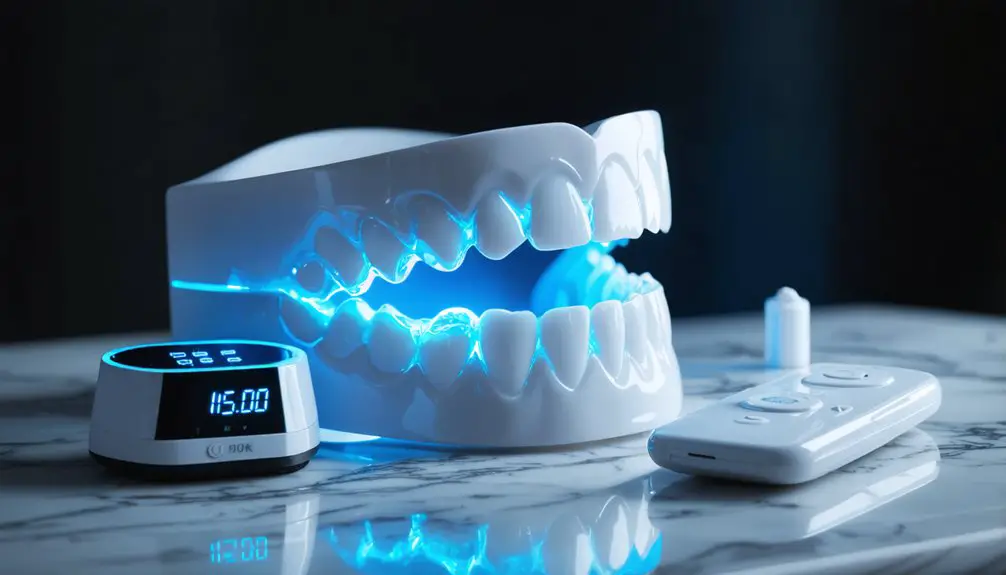
You’ll need to carefully follow the recommended treatment schedule of 9-30 minutes per session for at-home LED whitening, spacing treatments up to 21 consecutive days for best results.
It’s important to monitor session durations and never exceed manufacturer time limits, as longer exposure won’t improve results but may damage enamel.
After completing your initial whitening phase, allow several weeks of recovery time before starting maintenance treatments to prevent sensitivity and protect your dental health.
Follow Treatment Schedule Strictly
Following a strict LED teeth whitening schedule is essential for achieving ideal results while protecting your oral health. The treatment benefits become most apparent when you maintain consistent daily sessions of 9-30 minutes over a 14-21 day period. The treatment importance lies in preventing sensitivity while maximizing whitening effectiveness.
- Stick to manufacturer-recommended session lengths, typically under 30 minutes, to avoid gum irritation and enamel damage.
- Incorporate whitening sessions into your daily routine at the same time to guarantee consistency.
- Monitor your progress using the provided shade guide while maintaining regular treatments.
- Schedule maintenance sessions every 3-6 months to preserve your results, adjusting frequency based on sensitivity.
Monitor Session Time Limits
Proper timing of LED teeth whitening sessions is essential for achieving optimal results while protecting your oral health. Stick to session durations of 10 to 30 minutes for at-home treatments, and don’t exceed your kit’s recommended time limits, as longer exposure won’t enhance results.
For ideal safety and effectiveness, maintain timing control by following your product’s specific guidelines. Most kits suggest daily treatments for up to 21 days or periodic sessions every 6 to 12 months.
If you have sensitive teeth, opt for shorter sessions or reduce frequency to prevent discomfort. Watch for signs of sensitivity and adjust your treatment schedule accordingly.
Remember that professional oversight is valuable, especially if you have existing dental concerns. By carefully monitoring your whitening sessions, you’ll maximize results while preserving your enamel’s integrity.
Allow Recovery Between Treatments
When undergoing LED teeth whitening treatments, allowing adequate recovery time between sessions is essential for protecting your enamel and enhancing results.
The recovery importance can’t be overstated, as teeth whitening opens enamel pores, making them temporarily vulnerable to staining. To maintain ideal enamel health and prevent sensitivity, follow these key guidelines:
- Wait at least 24-48 hours between treatments to allow your enamel’s protective layer to regenerate.
- Schedule intensive whitening sessions several months apart to prevent enamel damage.
- Maintain a “white diet” for one week post-treatment, avoiding staining foods and beverages.
- Use desensitizing toothpaste during recovery periods if you experience sensitivity.
For long-term success, limit touch-up treatments to every six months, and always complete the full recovery period before resuming normal dietary habits.
Preventing Sensitivity and Discomfort
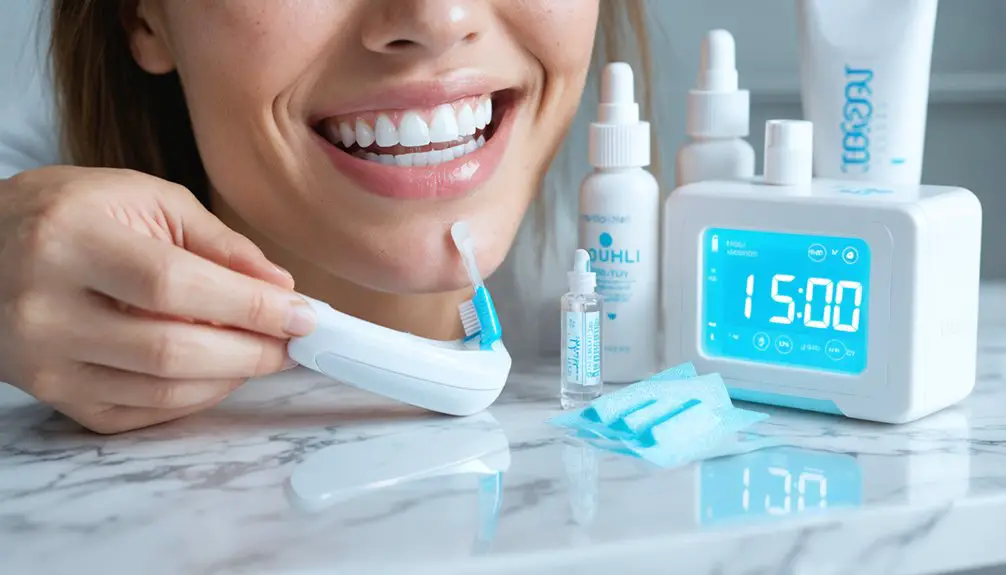
To minimize discomfort during LED teeth whitening, you’ll need to implement several protective measures before, during, and after treatment.
Start using desensitizing toothpaste containing potassium nitrate or fluoride two weeks before treatment for ideal sensitivity management. Choose whitening products with lower peroxide concentrations around 5-6% to protect your enamel.
After treatment, avoid extremely hot or cold foods and beverages for 48 hours, using room temperature alternatives instead. When consuming cold drinks, use a straw to minimize contact with treated teeth.
For enhanced enamel protection, stay away from acidic and sugary foods that can erode vulnerable enamel. Maintain gentle brushing techniques with a soft-bristled toothbrush, and continue using sensitivity-formulated toothpaste throughout your whitening journey.
Maximizing Gel-to-Tooth Contact
Successful LED teeth whitening depends heavily on maintaining ideal contact between the whitening gel and tooth surfaces.
Proper gel distribution techniques and mouthpiece adjustments considerably impact your whitening results.
- Apply gel directly to teeth using a Q-tip for even distribution, aiming for a 1mm thick layer.
- Verify teeth are clean and completely dry before application to maximize gel adherence.
- Adjust your mouthpiece fit to eliminate gaps and achieve full surface contact.
- Keep the mouthpiece stable throughout treatment while the LED light activates the gel.
For best results, avoid eating or drinking for 2-4 hours after treatment to allow residual gel contact.
Remember to apply fresh gel before each session and never reuse syringes beyond their recommended usage to maintain consistent whitening effectiveness.
Maintaining Safety During Treatment
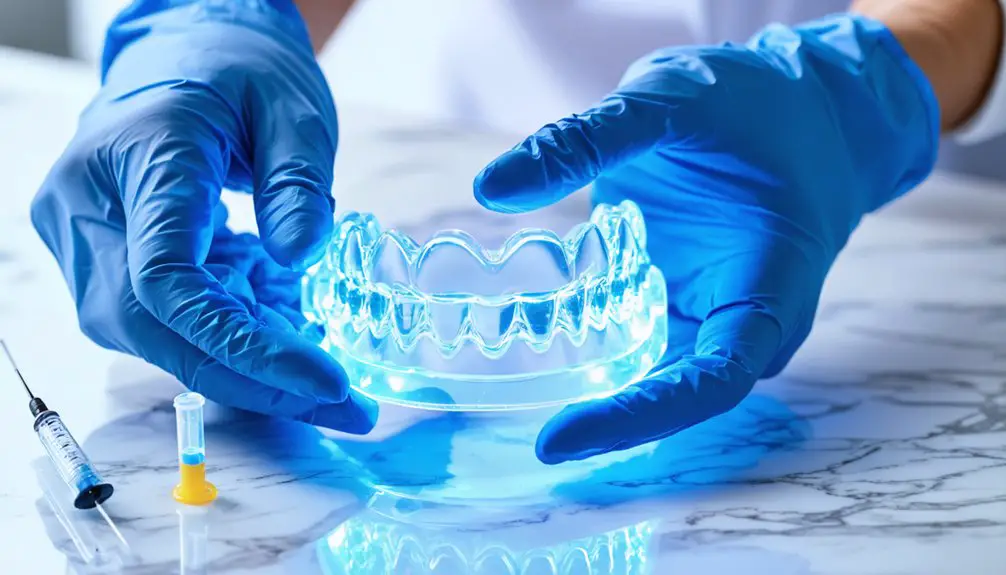
Safety stands at the forefront of LED teeth whitening procedures, requiring careful attention to product selection and application methods.
LED teeth whitening demands meticulous safety protocols, from selecting reputable products to following precise application techniques for optimal results.
Despite common whitening myths, you’ll need to choose dentist-approved or ADA-sealed kits with transparent ingredient lists to guarantee ideal protection.
Don’t fall for safety misconceptions about extended treatment times – always follow manufacturer’s instructions precisely.
You must avoid treatment if you have untreated cavities, gum disease, or oral infections.
When applying the gel, use custom-fit trays correctly to prevent gum contact.
If you experience sensitivity, switch to specialized toothpaste and temporarily pause treatment.
During the process, maintain gentle brushing techniques with a soft-bristled brush, and avoid acidic foods that could compromise your enamel’s integrity.
Post-Treatment Care Guidelines
To protect your newly whitened smile, you’ll need to follow strict dietary restrictions for the first 24 hours, avoiding all darkly colored beverages and staining foods.
Your immediate post-treatment care should include maintaining a “white diet” of light-colored, non-acidic foods for at least seven days while practicing gentle but thorough oral hygiene.
It’s crucial to manage any sensitivity with appropriate toothpaste and temporary dietary modifications, while scheduling periodic touch-ups to maintain your results long-term.
Maintain Your Bright Smile
Maintaining your newly whitened smile requires careful attention to post-treatment care during the first 48 hours and beyond.
Contrary to common whitening myths, your enamel needs time to recover and remineralize after treatment. To protect your investment and guarantee ideal results, you’ll need to follow specific guidelines for enamel care and stain prevention.
- Don’t eat or drink anything for at least 3 hours post-treatment, then stick to white or clear foods for 48 hours
- Use a soft-bristled toothbrush with non-colored fluoride toothpaste twice daily
- Avoid staining substances like coffee, red wine, and tobacco for at least 7 days
- Schedule touch-up treatments every six months, especially if you regularly consume staining beverages
Remember to manage any sensitivity with desensitizing toothpaste and over-the-counter pain relief if needed.
Prevent Staining After Treatment
While your newly whitened teeth may look spectacular, protecting your investment requires strict adherence to post-treatment guidelines. One of the common mistakes is consuming staining substances too soon after treatment.
Avoid dark beverages like coffee, red wine, and tea for at least 14-20 days. You’ll also need to steer clear of highly pigmented foods such as berries, beets, and soy sauce.
Don’t fall for whitening myths that suggest brief exposure won’t matter – the first 48 hours are vital for allowing your enamel pores to close properly.
Stick to a “white diet” including foods like cauliflower, pasta, and white cheese for seven days. When you do consume potentially staining items, brush immediately with water or white toothpaste to minimize discoloration risks.
Tracking Your Whitening Progress

Successful LED teeth whitening depends on accurate progress tracking to achieve ideal results and prevent overtreatment. Regular shade assessment using standardized guides and consistent photo documentation helps you monitor changes effectively.
Professional progress evaluation combines visual tracking with advanced measurement tools for excellent outcomes.
Track your whitening journey with these proven methods:
- Use a standardized shade guide to document your starting color and changes every 3-5 days
- Take consistent photos under the same lighting conditions to capture gradual improvements
- Maintain a treatment diary noting session times, sensitivity levels, and dietary factors
- Schedule professional check-ups for expert assessment and treatment adjustments
Consider using mobile tracking apps with AI analysis features to quantify improvements and receive timely alerts when you’ve reached your desired shade level.
Long-Term Results and Touch-Ups
The long-term success of LED teeth whitening depends on both your initial treatment protocol and ongoing maintenance strategy. While results can last up to three years, you’ll need to implement proper long-term maintenance to preserve your brighter smile.
Professional treatments typically deliver more enduring results than at-home LED kits, but you can extend whitening effects through strategic touch-up frequency. Plan for touch-up sessions every few months, or when you notice discoloration returning.
To maximize longevity, avoid staining foods and beverages for 48 hours post-treatment, maintain thorough oral hygiene, and use whitening-friendly products. Consider incorporating fluoride-based sensitivity management if needed.
For ideal results, address any underlying dental issues before starting treatment, and continue regular dental check-ups to monitor your whitening progress and maintain enamel health.
Frequently Asked Questions
Can I Use LED Teeth Whitening While Pregnant or Breastfeeding?
Due to safety concerns, you shouldn’t use LED teeth whitening while pregnant. Wait until after pregnancy and breastfeeding, or try alternative options like whitening toothpaste and natural remedies instead.
Will LED Teeth Whitening Remove White Spots or Calcium Deposits?
LED teeth whitening won’t remove calcium deposits or white spots completely. While it can temporarily mask their appearance through overall whitening effectiveness, you’ll need professional treatment for permanent removal of these issues.
Can Teenagers Safely Use LED Teeth Whitening Kits?
You shouldn’t use LED teeth whitening until you’re at least 14-16 years old. Your teenage dental health requires professional supervision for safe whitening practices, as young teeth are vulnerable to damage.
Does Smoking Affect the Results of LED Teeth Whitening Treatment?
Yes, smoking severely compromises your whitening results by causing rapid stain recurrence, weakening your enamel, and creating deeper discoloration that’s harder to treat with LED whitening systems.
Can I Use LED Whitening With Dental Implants or Bridges?
You can safely use LED whitening with implants and bridges, but it won’t change their color. While dental safety is assured, whitening effectiveness only occurs on natural teeth, creating potential shade differences.
References
- https://pmc.ncbi.nlm.nih.gov/articles/PMC3466022/
- https://pmc.ncbi.nlm.nih.gov/articles/PMC4058574/
- https://www.healthline.com/health/dental-and-oral-health/blue-light-teeth-whitening
- https://www.matthewsfamilydentistry.com/blog/do-at-home-teeth-whitening-kits-work/
- https://www.ada.org/resources/ada-library/oral-health-topics/whitening
- https://www.trysnow.com/blogs/news/what-to-do-before-teeth-whitening
- https://shopzimba.com/blogs/news/how-to-use-teeth-whitening-kit
- https://icybeardental.com/blogs/blog/teeth-whitening-for-beginners
- https://www.laserglowspa.com/blogs/news/5-things-to-know-before-your-first-led-whitening-session-laserglow
- https://sinsationalsmile.com/products/take-home-whitening-treatments-1
